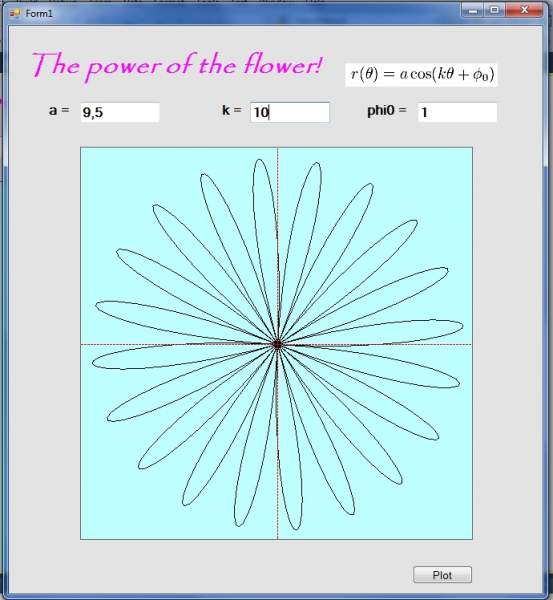What polar coordinates are is explained here.
I wanted to draw some polar functions myself, so I changed my plotting class a bit and added a polar struct to a new project.. Just posted code for the Plot class and the polar point structure here. You can find an example of output as well, and the complete project in a zip file.
This is just a basic thingy, so error correction is also basic. Enjoy! :)
Flowerpower! Drawing in polar coordinates in C#.
kvprajapati commented: cool! +15
using System;
using System.Collections.Generic;
using System.Linq;
using System.Text;
using System.Drawing;
namespace PolarFlowers
{
/// <summary>
/// class to plot x and y values on a Form or Panel
///
/// Because on the form coordinates start at the upper left corner with 0,0
/// with the y coordinate going down, a little transformation is done here
/// so that x,y coordinates act as normal carthesian coordinates, with 0,0
/// in the center of the Form or Panel
/// </summary>
class Plot
{
struct PlotPort
{
public int minX;
public int maxX;
public int minY;
public int maxY;
};
private PlotPort _PlotW; //"window" of carthesian coordinates
private Size _ClientArea; //keeps the pixels info
private float _Xspan;
private float _Yspan;
public Plot() { }
public Plot(Size Plotarea)
{
_ClientArea = Plotarea;
}
public Size ClientArea { set { _ClientArea = value; } }
/// <summary>
/// Set the bounderies of the form(screen) to real(world) coordinates.
/// </summary>
/// <param name="minx">lowest x value</param>
/// <param name="maxx">highest x value</param>
/// <param name="miny">lowest y value</param>
/// <param name="maxy">highest y value</param>
public void SetPlotPort(int minx, int maxx, int miny, int maxy)
{
//set the bounderies of the form(screen) to real coordinates.
_PlotW.minX = minx;
_PlotW.maxX = maxx;
_PlotW.minY = miny;
_PlotW.maxY = maxy;
_Xspan = _PlotW.maxX - _PlotW.minX;
_Yspan = _PlotW.maxY - _PlotW.minY;
}
public void PlotPixel(PointF P, Color C, Graphics G)
{
//workhorse of this class
Bitmap bm = new Bitmap(1, 1);
bm.SetPixel(0, 0, C);
P = ToScreen(P);
G.DrawImageUnscaled(bm, (int)P.X, (int)P.Y);
}
public void PlotAxes(Graphics G)
{
Pen AxisPen = new Pen(Color.Red);
AxisPen.DashStyle = System.Drawing.Drawing2D.DashStyle.Dash;
// X-Axis
PointF X0 = new PointF( _PlotW.minX, _PlotW.minY + _Yspan / 2f);
PointF X1 = new PointF( _PlotW.maxX, _PlotW.minY + _Yspan / 2f);
//Y-Axis
PointF Y0 = new PointF(_PlotW.minX + _Xspan / 2f, _PlotW.maxY);
PointF Y1 = new PointF(_PlotW.minX + _Xspan / 2f, _PlotW.minY);
G.DrawLine(AxisPen, ToScreen(X0), ToScreen(X1));
G.DrawLine(AxisPen, ToScreen(Y0), ToScreen(Y1));
}
/// <summary>
/// Plot a list of carthesian points on the screen
/// </summary>
/// <param name="thePts"></param>
/// <param name="G"></param>
public void PlotPoints(List<PointF> thePts,Pen P, Graphics G)
{
//for (int k = 1; k < thePts.Count; k++)
//{
// G.DrawLine(P, ToScreen(thePts[k - 1]), ToScreen(thePts[k]));
//}
PointF[] PtAr = thePts.ToArray();
for (int k = 0; k < PtAr.Length; k++)
{
PtAr[k] = ToScreen(PtAr[k]);
}
G.DrawLines(P, PtAr);
}
/// <summary>
/// Transform a point incarthesian coordinates to a point on the screen
/// </summary>
/// <param name="ptC">The point in carthesian(world) coordinates</param>
/// <returns>Transformed point to be plotted on the screen</returns>
private PointF ToScreen(PointF ptC)
{
PointF aP = new PointF();
aP.X = _ClientArea.Width / _Xspan * ptC.X + _ClientArea.Width / 2f;
aP.Y = _ClientArea.Height / _Yspan * ptC.Y + _ClientArea.Height / 2f;
return aP;
}
}
}
//******************************************************************************
using System;
using System.Collections.Generic;
using System.Linq;
using System.Text;
using System.Drawing;
namespace PolarFlowers
{
/// <summary>
/// A polar point defined by the radius (r) and the angle (Theta)
/// </summary>
public struct PolarPointF
{
public PolarPointF(float r, float Theta) : this()
{
this.r = r;
this.Theta = Theta;
}
public float r { get; set; }
public float Theta { get; set; }
/// <summary>
/// Converts a polar point to a carthesian coordinates, with Theta expressed in radians
/// </summary>
/// <returns>A PointF structure</returns>
public PointF ToCarthesian()
{
return new PointF((float)(this.r * Math.Cos(this.Theta)), (float)(this.r * Math.Sin(this.Theta)));
}
/// <summary>
/// Converts a PointF, representing carthesian coordinates to a PolarPointF
/// </summary>
/// <param name="P"></param>
/// <returns></returns>
public static PolarPointF FromCarthesian(PointF P)
{
float r = (float)Math.Sqrt(P.X * P.X + P.Y * P.Y);
float Theta = (float)Math.Atan2(P.X, P.Y); // arctan with a "twist", see the Math class
return new PolarPointF(r, Theta);
}
}
} Be a part of the DaniWeb community
We're a friendly, industry-focused community of developers, IT pros, digital marketers, and technology enthusiasts meeting, networking, learning, and sharing knowledge.
